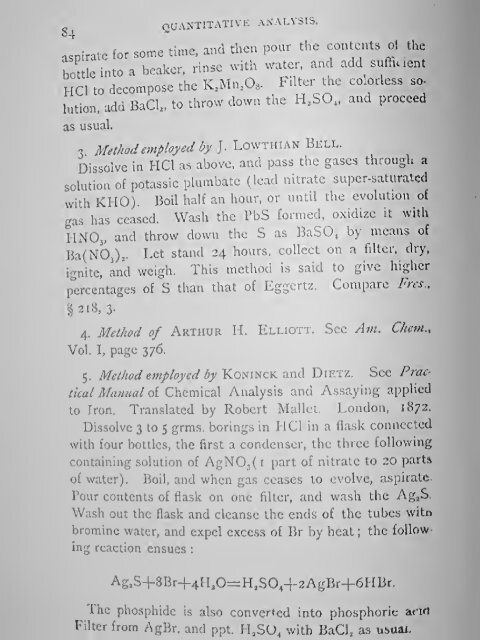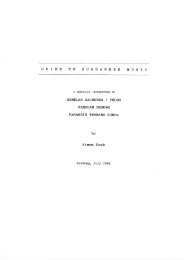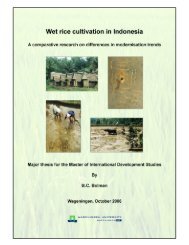The Students' Guide in Quantitative Analysis - Free Ebooks Library
The Students' Guide in Quantitative Analysis - Free Ebooks Library
The Students' Guide in Quantitative Analysis - Free Ebooks Library
Create successful ePaper yourself
Turn your PDF publications into a flip-book with our unique Google optimized e-Paper software.
QUANTITATIVE ANALYSIS,<br />
Jpirate for some time, and then pour the content, ol the<br />
Stle<strong>in</strong>to a beaker, r<strong>in</strong>se with water, and add snfhuent<br />
HCl to decompose the K.Mn.O,. Filter the colorless so-<br />
lution. add BaCl. to throw dow^i the H,bO„ and proceed<br />
as usual.<br />
3 Method employed by J. Lowthian Bell.<br />
Dissolve <strong>in</strong> HCl as above, and pass the gases through a<br />
solution of potassic pUunbate (lead nitrate super-saturated<br />
with KHO), Boil half an hour, or until the evolution of<br />
gas has ceased. Wash the PbS formed, oxidize it with<br />
IINOj, and throw down the S as BaSO^ by means of<br />
Ba(NOj),. Let stand 24 hours, collect on a filter, dry,<br />
ignite, and weigh. This method is said to give higher<br />
p^ercentages of S than that of Eggertz. Compare Fres.,<br />
I<br />
218, 3-<br />
4. Method of Arthur H. Elliott. See Am. Client.,<br />
Vol. I, page 376.<br />
5. Method emfbyed by Y^om^cK 2siA Dietz. See Prac-<br />
tical Manual oi Chemical <strong>Analysis</strong> and Assay<strong>in</strong>g applied<br />
to Iron, Translated by Robert Mallet. London, 1872.<br />
Dissolve 3 to 5 grms. bor<strong>in</strong>gs <strong>in</strong> HCl <strong>in</strong> a flask connected<br />
with four bottles, the first a condenser, the three follow<strong>in</strong>g<br />
conta<strong>in</strong><strong>in</strong>g solution of AgNOj( I<br />
part of nitrate to 20 parta<br />
of water). Boil, and when gas ceases to evolve, aspirate.<br />
Pour contents of flask on one filter, and wash the Ag^S,<br />
Wash out the flask and cleanse the ends of the tubes wltn<br />
brom<strong>in</strong>e water, and expel excess of Br by heat ; the follow-<br />
<strong>in</strong>g reaction ensues<br />
:<br />
Ag.S+8Br+4H,0=H,SO,+2AgBr+6HBr.<br />
<strong>The</strong> phosphide is also converged <strong>in</strong>to phosphoric acti<br />
Filter from AgBr. and ppt. H,SO, with BaCi, as U5uai.








